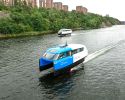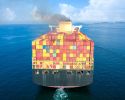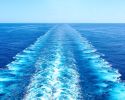In the future, the fairway will be created in real time

A large tanker, carrying hazardous cargo, is directed to a narrower and deeper corridor, while a smaller vessel can use a larger portion of the fairway. In the future’s dynamic fairways, the route will be tailored to each vessel’s specifications, combined with current conditions such as traffic, visibility, waves, and currents. This is the focus of new research funded by the Swedish Transport Administration.
Digitalization is increasing, and the development towards smarter and more autonomous shipping is progressing rapidly. New navigation services, remote control, virtual buoys, and other innovations will have a significant impact on our fairways. So, how will it look in the future when traditional ships and new remotely controlled or more autonomous ones have to share space? This has been investigated by RISE, the Swedish Maritime Administration, Chalmers, and SEAMADE in several studies, resulting in the report Conditions for Future Fairways.
"We have formulated two visions for the fairways of the future: one for the near future, where today’s ships can benefit from the new technology, and one for a more distant future, where advanced navigation support is more extensively installed onboard. We call the first one 2030 and the second one 2045, but the years should not be seen as absolute, but rather as approximate benchmarks for when these developments will occur," says Joakim Lundman, researcher at RISE and editor of the report.
In Vision 2030, the "smart fairway" is designed to ensure safe navigation for vessels with varying technological levels. Navigation support from land, or remote piloting as it is also called, has started to be used – it may not be very common yet, but there are examples where pilots coach ships from land. The Swedish Maritime Administration’s traffic centers (VTS, Vessel Traffic Service) will also play a more central role.
"Shipping will increase, which will make the fairways more crowded. Therefore, we believe that VTS, which is currently advisory, will take on a more guiding role to direct the traffic."
In the first vision, traditional buoys have also been partly replaced or supplemented with virtual ones, while dynamic nautical charts with real-time updates on water levels, currents, and depths will enable more efficient route planning and navigation.
"The buoys may also have become smarter and can share information, such as weather, wind, and currents," says Joakim Lundman.
Further ahead, in Vision 2045, digitalization and automation will have firmly taken hold in shipping to meet increased demands for efficiency. A large part of the fleet that exists today, in 2025, will be replaced, and vessels with high levels of automation or full autonomy will be common. Virtual navigation aids and augmented reality (AR) – technology that blends the real world with digitally created objects – will be used to provide real-time information to vessels' navigation systems. By now, the dynamic fairway has also been developed. With the help of digital charts and other dynamic and high-resolution data, fixed fairway markers can be opened up to larger navigable areas, adapted to current conditions such as traffic, visibility, depth, and weather. This makes shipping safer and more efficient.
"Through these dynamic values, the fairway can be specifically adapted for different ships. A smaller and more maneuverable vessel can, for example, be allowed to navigate in shallower waters, while a large oil tanker needs to stay within a narrow corridor due to weather conditions and wind. Instead of using the term 'fairway,' we now talk about a 'fairway surface.'"
This means that physical buoys must be replaced with virtual ones, which is of course a challenge. Both smart ships that use the technology and traditional vessels must be able to navigate the fairway.
"We conducted two different simulator studies of the fairways in and out of Gothenburg. In one of them, it was discovered that it felt empty without the physical markers. For the person steering the vessel and looking out over the fairway, there was nothing concrete to rely on. As a result, the person was forced to constantly look down at the chart, which felt risky, as the visibility of small boats and other objects that were not visible was lost. If such problems can be solved, there is much to gain from dynamic fairways. The simulator studies showed, for example, that one benefit of dynamic fairways is reduced fuel consumption. By taking wind and currents into account, the most fuel-efficient route into the quay in Gothenburg can be identified," says Joakim Lundman.
The report Conditions for Future Fairways is a compilation of four projects funded by Trafikverket. It is easy to read.
-
 NextWave – en podd som ska locka unga
NextWave – en podd som ska locka unga -
 Ny studie: Eldrivna pendelbåtar kan effektivisera Stockholms kollektivtrafik
Ny studie: Eldrivna pendelbåtar kan effektivisera Stockholms kollektivtrafik -
 Sjöfartens utsläpp ökar
Sjöfartens utsläpp ökar -
 Sociala relationer påverkar val av bränsle
Sociala relationer påverkar val av bränsle -
 Sjöfartens omställning kräver ”mjukare” påtryckningar
Sjöfartens omställning kräver ”mjukare” påtryckningar -
 Hon hade avtalad tid med Kapten ynkrygg
Hon hade avtalad tid med Kapten ynkrygg -
 Lighthouse omvärldsanalys 2025 – osäkerhet och tullar präglar sjöfarten
Lighthouse omvärldsanalys 2025 – osäkerhet och tullar präglar sjöfarten -
 Se seminariet Shipping in the Marine Environment
Se seminariet Shipping in the Marine Environment -
 Vad betyder egentligen de 90 procenten?
Vad betyder egentligen de 90 procenten? -
 Hålla där...
Hålla där...

